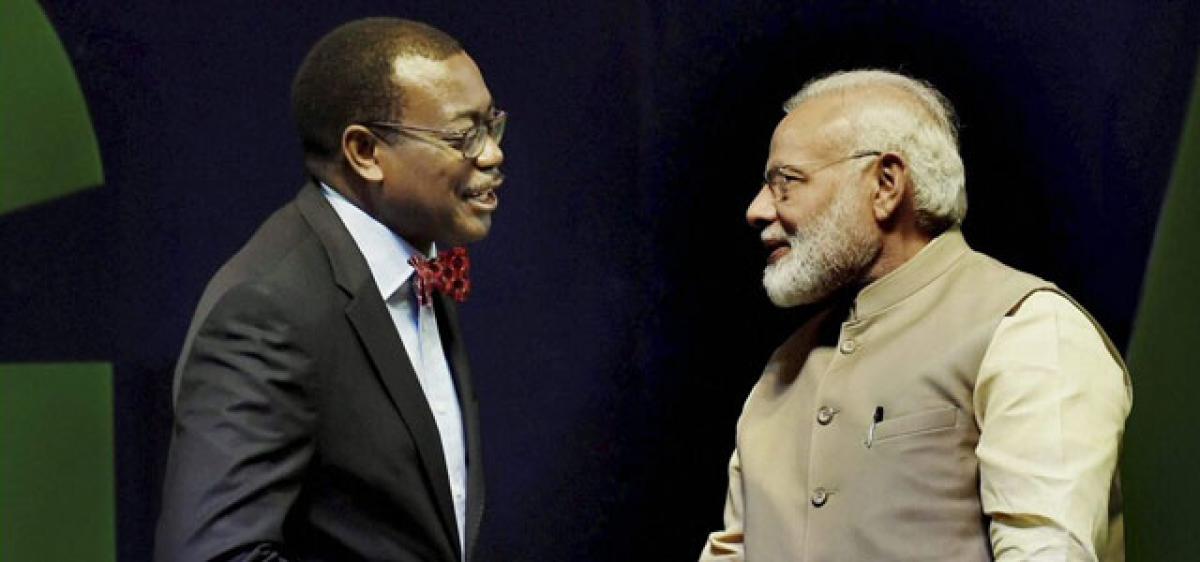Live
- BMW's another all-electric car launched in India
- Kajol’s style mantra of the day: Life is short, let my pallu be long
- IPL 2024: Sometimes it works, sometimes it doesn't work, says R Sai Kishore on being held back till 19th over
- Treating politician differently from ordinary criminal will violate Constitution: ED tells SC on CM Kejriwal's plea
- Adverse weather conditions may hit mango crops in UP: Experts
- Cong to snatch reservation from Dalits, says Union Minister Pralhad Joshi
- Congress tied hands of our soldiers, we gave them full freedom to retaliate: PM Modi
- Big B on being honoured with Mangeshkar Award: ‘Abhaar aur mera param saubhagya’
- Fashion Entrepreneur Fund opens up for pre registrations
- ICEA shares blueprint for India to become a global leader in chip value chain
Just In

During the recent annual meeting of the Africa Development Bank at Gandhinagar, Prime Minister Narendra Modi announced the launch of India’s latest initiative in Africa, the Asia-Africa Growth Corridor (AAGC), in partnership with Japan.
ASIA–AFRICA GROWTH CORRIDOR
During the recent annual meeting of the Africa Development Bank at Gandhinagar, Prime Minister Narendra Modi announced the launch of India’s latest initiative in Africa, the Asia-Africa Growth Corridor (AAGC), in partnership with Japan.
This initiative is the latest in a series of steps taken by India including the Third India Africa Forum Summit and a number of high level visits to 16 African countries over the last two years, all aimed to boost ties with the continent.
The Asia-Africa Growth Corridor highlights the growing importance of Africa in Indian foreign policy and also signals India’s willingness to partner with like-minded countries, such as Japan, in this region.
India in Africa
The Gandhinagar meeting has shifted the spotlight back to India’s relations with the 54 countries in Africa. India’s historical ties with this region are well known. Economic engagement with African countries has increased in the last two decades with a large number of public and private sector companies from India investing in Africa. Trade has seen a five-fold increase from $11.9 billion in 2005-2006 to $56.7 billion in 2015-16.
1 India engages with African countries at three levels: bilateral, regional and multilateral. India’s engagement with the continent is consultative and is, to a large extent, driven by the demands of the African countries.
Japan in Africa
Japan also has a long standing relationship with African countries. The main feature of Japan’s Africa policy is its support for African “ownership”. The most important Japanese initiative in Africa is the Tokyo International Conference on African Development (TICAD), which was set up in 1993 to promote Africa’s development and security through multilateral cooperation.
TICAD was launched at a time when, following the end of the Cold War, Western donors had reduced their economic assistance to Africa and did not consider the region to be strategically important. Thus, in recent years, both Japan and India have been engaging with African countries. To some extent, this engagement may be driven by efforts to garner support from the 54 African countries for their candidacy in a reformed United Nations Security Council (UNSC).
Asia–Africa growth corridor
India and Japan institutionalised a dialogue on Africa in 2010. Since then, they have been exploring the possibilities of cooperation in Africa’s socio- economic development. However, it was only during Prime Minister Narendra Modi’s visit to Japan in November 2016 that the idea of the two countries promoting a growth corridor between Asia and Africa was crystallised.
The main objective of the corridor is to enhance growth and connectivity between Asia and Africa. The corridor will focus on four areas:
Development Cooperation Projects, Quality Infrastructure and Institutional Connectivity, Enhancing Skills, and People-to-People Partnership. Agriculture, health, technology, and disaster management have been identified as the main areas of development cooperation.
According to the vision document, AAGC will focus on enhancing skills and research and development capacities in Africa. It will also strive to develop institutional, industrial and transport infrastructure in the Asia -Africa region. The corridor will facilitate greater people-to-people exchanges amongst the participating countries.
Even as it has launched the AAGC initiative, India has made it clear that it is not interested in joining China’s Belt and Road Initiative, which is seeking to revive the global economy through a 21st century silk road that traverses through Europe, Asia and Africa.
Its refusal to participate in the Chinese initiative is due to concerns about sovereignty given that the China Pakistan Economic Corridor (CPEC), a part of the Belt and Road, passes through Indian territory under Pakistan’s control. There is no doubt that comparisons will be made regarding the merits of the Indo-Japanese and Chinese initiatives.
Be that as it may, the AAGC marries India’s brand of human resources development and capacity building with Japan’s objective of delivering quality infrastructure in the region. Moreover, both India and Japan have consulted with think tanks in Africa and Asia while conceptualising this plan. Efforts should be made to fast track the next steps to turn these innovative ideas to reality. (Courtesy: idsa.in; The writer is Senior Research Associate at Institute for Defence Studies and Analysis, New Delhi)
By Ruchita Beri

© 2024 Hyderabad Media House Limited/The Hans India. All rights reserved. Powered by hocalwire.com







